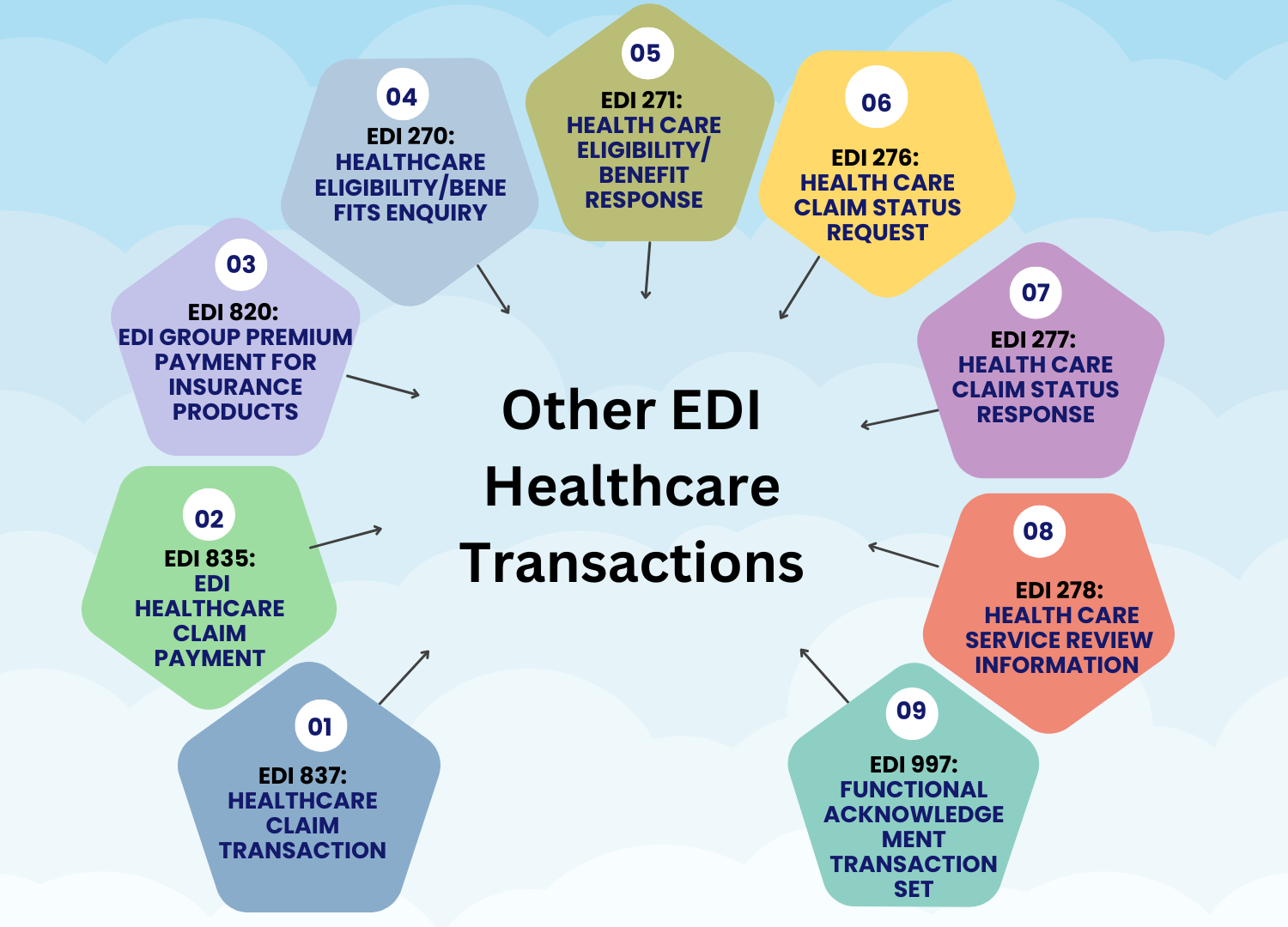The EDI 834 standard defines the electronic format and data content for purchase orders sent between businesses. New technology and processes are constantly changing the way companies implement and use EDI 834 services. Cloud-based EDI platforms have rapidly grown in popularity among organizations of all sizes. Companies now have the option to set up and manage their EDI connections without installing any specialized software. This allows for faster onboarding of new trading partners and greater scalability. This blog will help explain these upcoming EDI 834 trends in detail.
Advanced automated mapping tools have simplified the process of parsing, configuring, and translating EDI 834 data between different schemas. Companies can get up and running with new trading partners much quicker. Real-time EDI has enabled organizations to transmit and process purchase order information immediately, eliminating delays from manual data entry. Orders can be fulfilled faster and more accurately when updates are transmitted in real time.
As an alternative to traditional EDI, EditeXML provides a more flexible and on-demand document exchange format. EditeXML documents can be easily customized to meet the specific business rules of any company. This increases reliability while lowering support costs. Automating more of the EDI 834 service implementation process through tools like artificial intelligence and machine learning is another emerging trend. These technologies help reduce manual errors and configuration issues that plague many legacy EDI systems.
Defining EDI 834?
EDI 834 is an electronic data interchange standard. It is used for exchanging purchase order information between businesses. It also defines the format and data content for purchase order messages sent between trading partners, typically a buyer and supplier.
When a buyer needs to place an order with a supplier, they can send an EDI 834 Purchase Order transaction instead of a physical document. It also contains all the relevant information about the order, including:
- Product information – Product codes, descriptions, and quantities ordered
- Pricing – Unit prices and any applicable discounts
- Instructions – Shipping addresses, requested delivery dates, and special instructions
- References – This consists of Purchase order numbers, customer part numbers, and supplier part numbers
EDI 834 is electronically prepared by the supplier who returns an EDI 862 Purchase Order Acknowledgement. This is to indicate whether the order has been received or if there are any problems. Such an electronic interchange of purchase order information obviates the paper document and manual entry of its data, hence saving time and reducing human errors. It also allows trading partners to automate their order management business processes.
The Role of EDI 834 in the Healthcare Industry
EDI 834 is vital to healthcare organizations seeking to exchange electronic purchase order. Specifically information with their trading partners or suppliers. Here are some of the reasons why EDI 834 is critically important in healthcare:
Accuracy –
This means that EDI 834 services are devoid of manual data entry errors, which can mean ordering mistakes. This ensures that hospitals and clinics get the proper medical supplies and medications for patients.
Speed –
Electronic purchase orders are processed much faster than paper ones. This helps ensure supplies are available when needed for patient care.
Cost Savings –
Using EDI 834 reduces the cost of paper forms, printing, and data entry. These savings can be redirected to improve patient services.
Security –
EDI 834 transactions also use data encryption and authentication to maintain the privacy of patient information and order details.
Visibility –
EDI 834 service providers give visibility into order status and delivery times. This helps them better manage their supply chain and avoid stockouts.
Compliance –
EDI 834 also helps healthcare organizations comply with regulations that require electronic health record systems and data exchange standards.
EDI 834 purchase order exchange enables EDI 834 service providers to order supplies and medications more accurately, securely, and cost-effectively. The speed and visibility provided into the order process also help ensure patients receive continuous and coordinated care. EDI 834 has therefore become an important standard for streamlining supply chain management in the healthcare industry.

Evolution of EDI 834
The EDI 834 standard for electronic purchase order exchange has changed much in these past years, staying current with the ever-evolving needs of business. The first EDI 834 standard was launched in the late 1980s and helped in the electronic exchange of general data in purchase orders between trading partners.
In the early days, EDI 834 files were mostly used by large enterprises with the resources to implement costly on-premise EDI 834 solutions. Data exchange was often batch-based and took place through value-added networks.
Over time, several improvements were also made to the EDI 834 standard to support things like advanced product identification codes, more robust pricing, and expanded instructions.
In recent years, the rise of cloud-based EDI and new platforms like EditeXML has made EDI 834 accessible to small and medium businesses. These platforms offer features like automated mapping, real-time data exchange, and customization options.
The evolution of EDI 834 transactions has also largely mirrored trends in technology and business needs over the last 3 decades. From its roots as a basic interchange standard for large enterprises, EDI 834 is now a flexible and accessible solution for organizations of all sizes thanks to cloud computing and platform innovation.
Automation in EDI 834
Automation is playing an increasingly important role in purchase order exchange to help businesses operate more efficiently. As organizations look to streamline their supply chain processes, automation technologies are being leveraged in several ways within EDI 834 implementations:
Data mapping – Automated data mapping tools can parse, analyze, and configure EDI 834 data between different schemas with little to no human intervention. This speeds up the onboarding of new trading partners.
Rule-based processing – Businesses can also create automated rules to validate incoming EDI 834 purchase orders, flag errors, and route orders to the appropriate teams or systems. This reduces the need for manual review.
Transactions – Many repetitive EDI 834 transactions like purchase order acknowledgments can be automated to transmit quickly and accurately without human input.
Integration – EDI 834 data can also be automatically integrated with backend ERP and warehouse management systems using APIs. This populates ordering data in the relevant systems in real-time.
Automation is becoming critical for organizations using EDI 834 services to exchange purchase order data at high volumes, speeds, and accuracy. Technologies like automated data mapping, rule-based processing, and integration are helping businesses reduce manual work and errors while improving order cycle times.
Cloud-based Solutions for EDI 834
Cloud-based platforms have innovated the deployment and management of EDI 834 purchase order exchange. Traditionally, on-premise EDI 834 solutions require installment and maintenance of complex hardware and software.
Cloud-based EDI solutions run completely in the cloud, offering businesses easy, Web-based access from anywhere to manage all their EDI connections. There is no need for servers or installation and maintenance of software; all the infrastructure and technology are managed by EDI 834 providers.
This offers several key benefits for organizations using EDI 834:
Speed – Companies can quickly set up and enable EDI 834 connections with trading partners in just a few steps. This expedites the onboarding of new suppliers and customers.
Scalability – Cloud-based EDI easily scales to support fluctuating transaction volumes and a growing number of trading partners. There are no limits on hardware resources.
Cost Reduction – Companies also pay a low subscription fee rather than large upfront and ongoing costs for on-premise EDI 834 solutions. There are also no IT resource requirements.
Uptime – Cloud platforms also provide high availability, reliability, and failover capabilities that ensure EDI 834 transactions are processed continuously.
Mobility – It also enables access from any internet-connected device. This allows the employees to manage orders from anywhere.
Cloud-based EDI 834 solutions let organizations quickly and effectively meet changing market conditions. It promotes agility, scalability, affordability, and reliability while optimizing its supply chain processes. By moving to the cloud, companies of all sizes can quickly enable secure and compliant EDI 834 purchase order exchange.
Get in touch with us for EDI 834 services
Artificial Intelligence (AI) in EDI 834
AI and ML making their way into how organizations implement and use EDI 834 files Purchase Order exchange. AI technologies can automate repetitive, manual tasks. All the while providing actionable insights that improve supply chain efficiency.
Some of the probable advantages that AI can bring to EDI 834 are given below:
Faster Data Mapping – AI-driven tools will automatically parse, normalize, and map the EDI 834 data between schemas. Onboarding a new trading partner is now easier and faster.
Error Detection – Training AI algorithms to detect syntax errors, inconsistencies in data, and mismatches within EDI 834 documents has been done. In this way, compliance issues can be reduced by this algorithm, which significantly minimizes delays in order processing.
Anomaly Detection – By using AI to spot deviating patterns in EDI 834 order volumes, product quantities, and other measurements, businesses can discover anomalies pointing toward possible cases of fraud or potential supply issues.
Demand Forecasting – Using AI models to forecast demand correctly for products through historical data of EDI 834 purchase orders, which will help optimize inventory levels and minimize stockout.
Optimized Order Fulfillment – This will provide the most efficient manner and sequence of order fulfillment that will take into account product features, in-stock position, and cost of shipment.
Intelligent Order Processing – As AI systems learn more about what suppliers can or cannot deliver, EDI 834 orders can be dynamically changed to ensure the completion of orders.
The same could be said about AI and machine learning, which make it possible to transform EDI 834 files into cogent, adaptive, and efficient vehicles with the automation of repetitive tasks, excellence in executing accuracy, optimization of fulfillment processes, and offering recommendation models of overall supply chain performance maximization. These are more so in a nascent stage for EDI 834 but are likely to evolve.
Blockchain Technology in EDI 834
It may make the EDI 834 purchase order exchange seamless, more secure, and more transparent with blockchain technology and greater automation. Here are a few ways blockchain might enhance EDI 834:
- Immutable Record Keeping: All transactions related to the service of EDI 834 can also be recorded on an immutable blockchain ledger. This would ensure that purchase orders cannot be altered or forged and provide transparency for all parties.
- Automated Ordering and Fulfillment – The smart contracts can be applied to process the fulfillment of EDI 834 purchase orders automatically as per predefined business rules, without any manual intervention and errors.
- Improved Tracking – Every transaction on the blockchain is time-stamped, leading the trading partners to have the opportunity to track the full cycle of an EDI 834 purchase order right from its creation to fulfillment.
The same distributed ledger provides all parties with a single source of truth, thus offering complete visibility over order status and delivery times to suppliers and buyers alike.
- Reduced Reconciliation – Since every transaction is recorded on an immutable ledger, there is no need to reconcile the EDI 834 purchase order data after the fact by partners.
- Greater Security: Since blockchain is decentralized by nature, it is also immutable to transaction record tampering. This provides an added layer of security to sensitive EDI 834 purchase order information.
Blockchain will indeed be a game-changer in EDI 834, through features such as cryptography, immutability, transparency, automation, and distributed consensus. The same could reduce cost, and improve efficiency, and reliability in EDI 834 order management processes by removing all reconciliation work and manual errors. However, comprehensive blockchain adoption for EDI 834 is still years away.
Mobile Applications for EDI 834
Mobile applications are increasingly being used by companies to manage their EDI 834 purchase order exchange on the go. The apps allow employees to access key EDI 834 files from any smartphone or tablet, even when away from their desks.
Common features of mobile apps for EDI 834 service include:
- Viewing incoming purchase orders and order statuses in real time
- Approving or rejecting orders from suppliers
- Requesting order changes or cancelations
- Checking inventory levels to ensure orders can be filled
- Viewing and tracking shipment statuses
- Communicating order issues with suppliers and customers
- Accessing EDI mapping configurations and transaction histories
Many mobile EDI 834 apps integrate with companies’ backend ERP and warehouse management systems to provide the most up-to-date order information. They also connect to companies’ cloud-based EDI platforms to manage EDI 834 transactions.
The benefits of mobile EDI 834 apps also include better responsiveness, faster order processing, improved visibility into the ordering process, and the ability for employees to manage orders from any location. However, security measures must also be implemented to ensure sensitive order data remains protected.
Data Analytics and Reporting in EDI 834</span.
The analytics and reporting of EDI 834 are applied to derive insights by companies. Such tools extract, organize, and analyze EDI 834 data and present useful information and metrics to the business.
Common data analyses that can be performed on EDI 834 data include:
- Purchase order and line item volumes by trading partner
- On-time delivery and order fulfillment rates
- Average order sizes and product unit prices
- High turnover and slow-moving products
- Order error and rejection rates by trading partner
- Transaction volume trends over time
Reports generated from EDI 834 data help businesses identify opportunities to improve supply chain performance, adjust inventory levels, negotiate prices, spot outliers or anomalies, and troubleshoot issues.
Tools that integrate directly with companies’ EDI platforms and back-end systems provide the most accurate and up-to-date EDI 834 data.
- Make more informed business decisions
- Set improvement goals
- Identify process inefficiencies
- Adjust supply planning
- Negotiate terms with trading partners
- Optimize inventory levels and product mix
Interoperability and Standardization in EDI 834
These are important in ensuring appropriate EDI 834 purchase order exchange between businesses. Interoperability refers to the ability of different EDI systems to connect and exchange data accurately.
EDI 834 also provides a standard format that all trading partners may use. It is useful for exchanging purchase order information electronically. This will ensure interoperability between the different EDI 834 solutions that can be used by suppliers, distributors, and manufacturers.
The organizations, like X12 and UN/EDIFACT, have so far developed and maintained the EDI 834 standard. All the modifications that are done to the standard should be approved to make sure there is backward compatibility.
Interoperability calls for trading partners to map their data to the EDI 834 standard. They also test transactions between EDI systems. If there are any mismatches in elements, codes, or formats, it will cause problems with interoperability. Most cloud-based EDI platforms have tools that automate the mapping and testing processes, making setup easier for businesses.
Security and Privacy in EDI 834
Security and privacy are critical considerations for organizations using EDI 834 to exchange purchase order data electronically. EDI 834 transactions often contain sensitive business information and details about suppliers, products, and customers. Trading partners need to implement proper security controls and safeguards to protect this information.
Some key security measures for EDI 834 implementation include:
Data Encryption – Sensitive EDI 834 data should be encrypted in transit and also at rest in storage. This prevents unauthorized access to purchase order contents.
Authentication – Trading partners should authenticate each other’s identities before accepting and processing EDI 834 transactions. This ensures messages come from the supposed sender.
Access Control – Users should be assigned appropriate permissions based on their job roles to access and modify specific EDI 834 data. This prevents improper data disclosure.
Firewalls – Firewalls can also restrict inbound and outbound EDI 834 traffic to approved IP addresses of known trading partners. This limits exposure to potential threats.
Threat Monitoring- Systems should be monitored for suspicious activity, such as multiple failed attempts at log in, to identify any hackers.
Incident Response- An organization should also have an incident response program in place to contain or reduce security threats against their EDI 834 exchange.
In summary, proper security controls and safeguards are necessary to protect the confidential purchase order information transmitted via EDI 834. Data encryption, authentication, access control, and network defenses help organizations secure their electronic data interchange and maintain the privacy of their trading partners’ data.

Future Outlook for EDI 834
The future of EDI 834 looks promising as technologies advance and businesses demand more efficiency from their electronic data interchange. Cloud-based solutions will continue becoming cheaper and easier to use, attracting more organizations to EDI 834. Automation through artificial intelligence and machine learning has also the potential to transform EDI 834, enabling intelligent order processing and optimizing supply chains.
Emerging technologies like blockchain, the Internet of Things, and 5G networks may open up new possibilities for real-time EDI 834 at larger scales. The EDI 834 standard itself will also evolve to support new business processes, data elements, and product identification codes.
Conclusion
The shift to cloud-based EDI platforms is enabling faster setup, easier management, and better scalability. Advanced automated mapping tools are speeding up integration efforts and onboarding of new trading partners. Real-time EDI allows for immediate transmission and processing of orders to reduce delays. Alternative formats like EditeXML offer more flexibility and customization to meet organizations’ unique needs. Automation through emerging technologies has the potential to minimize manual errors in EDI systems.
All these will directly benefit the company that employs EDI 834 in the form of a reduction of costs, acceleration of order processing time, a change in the accuracy of orders, and transparency in visibility related to supply chain operations. With the adoption of the latest technological innovations, businesses will not only streamline their processes of purchase order management but, on the other hand, will gain an up upper edge in competition. The future of EDI 834 is bright, with innovators bending over backward to make electronic data exchange faster, easier, and more valuable for organizations big and small.
FAQs
What is the use of EDI 834?
EDI 834 enables entities to transmit purchase order information electronically between trading partners. Instead of faxing or mailing paper purchase orders, companies can send an EDI 834 that outlines all relevant order information in an extremely standardized manner. This includes product codes and descriptions, ordered quantities, pricing information, ship-to addresses, ship dates, and special instructions.
The suppliers process the EDI 834 orders electronically and return acknowledgments indicating confirmation of receipt or reason for rejection back to the buyers in case of any problem. Companies can automate their order management process without errors of manual data entry by using EDI 834.
What information will you find in EDI 834?
An EDI 834 purchase order transaction contains every element that a supplier will need to fill the order: product codes and descriptions, quantities ordered of each product, unit prices and applicable discounts, shipping addresses and instructions, requested delivery dates, purchase order numbers from the buyer, buyer’s part numbers and supplier’s part numbers.
This shall comprise all the details that a supplier needs to process and ship an order electronically in the standardized EDI 834 format. Following this is the EDI 862 transaction, sent back to the buyer, which serves as an acknowledgment to the information on the acceptance of an order, problems, or changes therein.
What are the elements of the 834 files?
These shall comprise the key elements of EDI 834 files: product identifiers and description, ordered quantities, prices, delivery dates requested, shipping addresses and instructions, purchase order numbers, buyer’s part numbers matched to supplier’s part numbers, and any applicable notes or special requirements.
These are also according to the EDI 834 files format, which ensures that all ordering information is provided in a format parseable and usable for order fulfillment by trading partners. In turn, the receiving businesses produce EDI 862 acknowledgment transactions to confirm the receipt of the order, referencing many of the same elements, to indicate order acceptance or issues.
What is EDI filling?
EDI filling is the process of converting non-EDI information into EDI format to exchange and process it electronically.
This typically also involves data capture technology to extract order details from the non-EDI document, along with mapping rules and translations to confirm the data to the correct EDI format. Then, the resulting EDI 834 transaction is transmitted, processed, and integrated electronically with the business’s internal systems. EDI filling also bridges the gap between traditional and electronic order exchange.
What are the 4 major components of EDI?
The 4 major components of any Electronic Data Interchange (EDI) system – including EDI 834 – are:
Standards – EDI relies on standardized formats like EDI 834 files so systems can interpret the data correctly.
Translation – Programs translate non-EDI data into EDI formats and vice versa.
Transmission – The trading partners transmit the EDI data using networks or VPNs.
Processing – Trading partners must have systems that can process incoming EDI documents, take appropriate action, and generate responses or acknowledgments.
Together these 4 components – standards, translation, transmission, and processing – enable the electronic exchange of information between organizations using EDI.












